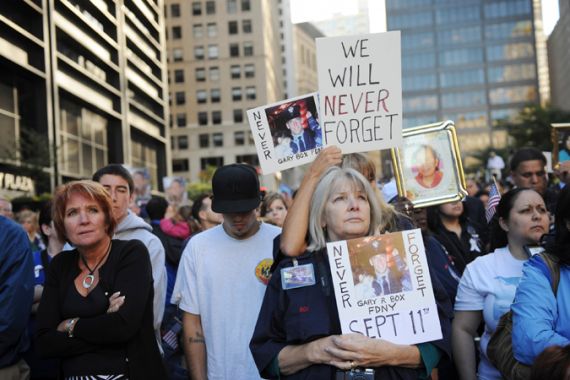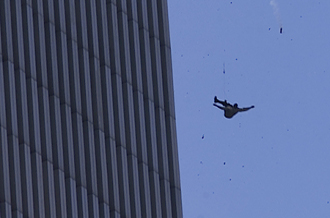The falling man: 9/11’s private moments
Images from 9/11 reveal people had an array of reactions, yet ten years on the event is stripped from the individual.

 |
| For the victims of 9/11, the attacks were not a historical moment, but a violent happening [Reuters] |
World-historical events – and unquestionably September 11 is the defining one of our time – contain within them a paradox: They strip the individual of agency and subsume the individual into a grander narrative. And yet at the same time, the event is only provided significance by, and for, the very human society it has rendered powerless.
The evidence is partially found in the aesthetic remnants of that moment – particularly the photographic images distributed through world news media.
Surveying the many photomontages and essays that are being used to mark its tenth anniversary is almost to relive the Towers’ dramatic removal.
In a perverse way one idly and passively peruses reels of pictures – images mostly detailing the moments immediately before and after the planes and buildings met, from every conceivable angle and point in time.
In the same way that the three targets of September 11 were aesthetic symbols of US power – of commerce, of security intelligence, and of government – so too was the US response, in a large part, aesthetic. What results from engaging in this mythologising process is an absent presence of the Towers in ones thoughts and feelings.
Indeed, arguably the preoccupation with broadcasting looped footage and still images in world news media – both then and now – was less about communicating or understanding the new reality than it was a fascination with the sublime beauty of devastation. For decades prior to their destruction, scores of social commentators remarked on the aesthetic quality of the twin structures that, to them, embodied the notions of American imperialism, the limits of human achievement, and global capitalism.
Following September 11, Jean Baudrillard, a French sociologist, revisited these earlier sentiments when he spoke of the Towers in these terms:
| “The horror for the 4,000 victims of dying in those towers was inseparable from the horror of living in them – the horror of living and working in sarcophagi of concrete and steel. By the grace of terrorism, the World Trade Centre has become the world’s most beautiful building – the eighth wonder of the world. Terrorism merely […] puts the finishing touches to the orgy of power, liberation, flows and calculation which the twin towers embodied […] So, at Ground Zero, in the rubble of global power, we can only, despairingly, find our own image.” |
The visual record of the spectacle demands us to experience the sublime philosopher J Glenn Gray foresaw in his masterful meditation on the Second World War, The Warriors: Reflections on Men in Battle:
| “If ever the world is blown to bits by some superbomb, there will be those who will watch the spectacle to the last minute, without fear, disinterestedly and with detachment. I do not mean that there is lack of interest in this disinterestedness or lack of emotion in this detachment. Quite the contrary. But the self is no longer important to the observer; it is absorbed into the objects with which it is concerned.” |
 |
| 9/11’s significance is partly manufactured by efforts to give a deplorable act some greater meaning [GALLO/GETTY] |
As well as September 11 no longer posing any physical danger, the awe described by Gray is only heightened when one considers that all this was caused by a handful of passenger planes, 19 men and some box cutters.
Without irony, what stands there today is a chimerical monument of light. However, arguably all that is marked by this display is the Towers’ absence. In many ways the twin beams further humiliate America in this most public of tragedies. Designs of the Freedom Tower that will take the Towers’ place – with its brash, reflective glass façade – will only serve to preserve this idea in memoriam.
Writing very soon after the event, Don DeLillo reasoned that the structural damage to these aesthetic symbols of American power had dictated the terms of our age. And yet, for DeLillo, how that act was responded to would have consequentialist ramifications such that, quite positively, “The narrative ends in the rubble and it is left to us to create the counternarrative”. Arguably, however, it was up to “us”; the United States and its allies have predominately followed the terrorist’s interaction script, leading to ongoing conflicts in Iraq, Afghanistan and now elsewhere.
In this way, September 11 was a world-historical event because it was made so; its significance partly manufactured by efforts to give a simply deplorable act some greater meaning.
That all said, a small number of images sporadically appeared that betrayed the overarching narrative of September 11 as a world-historical moment. Indeed, what binds a great number of these formerly orphaned images together are their preoccupation with the private moment – a man running for his own life, an office worker trapped, a fireman’s expended body and mind.
The closer study of two particular images captures this tension most forcefully.
One image, now known as “The Falling Man” – taken by photographer Richard Drew – depicts a man plummeting from the Towers at 9:41 AM on September 11. The positioning of the photographer relative to the subject and the surrounding instils an uneasy notion that his trajectory deliberately dissects the North and South Towers, as if uniting them one last time.
 |
| This is one of the estimated 200 people who jumped to their deaths from the World Trade Center towers [GALLO/GETTY] |
At the time “The Falling Man” was first shown in print and online news media, the public were so angered by its “exploitative” and “voyeuristic” depiction of one man’s “private moment” that it was seldom seen again – The New York Times showing it only once and the editors of its original publishers, The Morning Call, later conceding that “it might have been better if it had been a week later, in a collection, not as big, not in color”.
From this moment, images capturing “jumpers” plummeting from the towers were airbrushed out, and official statements employed vague wording to suggest that in fact no one had jumped, but rather had been blown out due to secondary explosions. In total, it is now estimated around 200 people jumped to their deaths as had, the man in that image.
Another image that first appeared more than four years after the attacks has aroused an equal amount of controversy. The image itself is rather plain: it contains five young people on the water’s edge enjoying what appears to be an impromptu picnic – there is a small amount of food, a bicycle propped up against the balustrade. In the background, across the harbour from Brooklyn, the Towers are on fire, and smoke is beginning to engulf within its folds the entire skyspace of Lower Manhattan. What one asks themselves upon seeing this image is simply this: What were they thinking?
In a recent discussion regarding the photo, its creator, Thomas Hoepker, reasons that he took so long to publish it merely because he felt that, “Publishing it might distort the reality as we had felt it on that historic day”, which might “stir the wrong emotions”.
Hoepker seems to say he was aware this image, while a valid document, did not contribute to the dominant grand narrative that was being constructed.
Arguably, however, these two consciously reflective images sought to display how – at least at those particular moments in time – people in all manner of settings still possessed the capacity to respond to the event as they saw fit. With fear, surprise, sadness, anger, awe, anticipation, or even indifference.
Simply put, to them this was not – yet – a world-historical moment, but a violent happening with unforeseen consequences.
NAJ Taylor is a PhD candidate in the School of Political Science and International Studies at the University of Queensland, and casual lecturer in the Faculty of Law and Management at La Trobe University.
Follow him on Twitter: @najtaylordotcom
The views expressed in this article are the author’s own and do not necessarily reflect Al Jazeera’s editorial policy.
